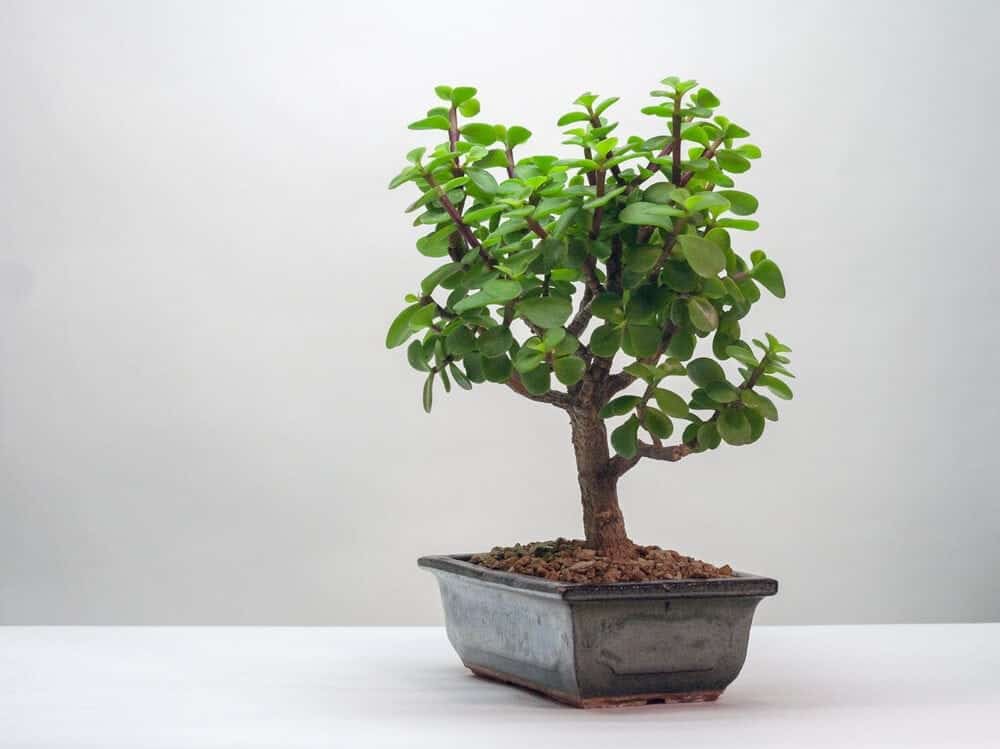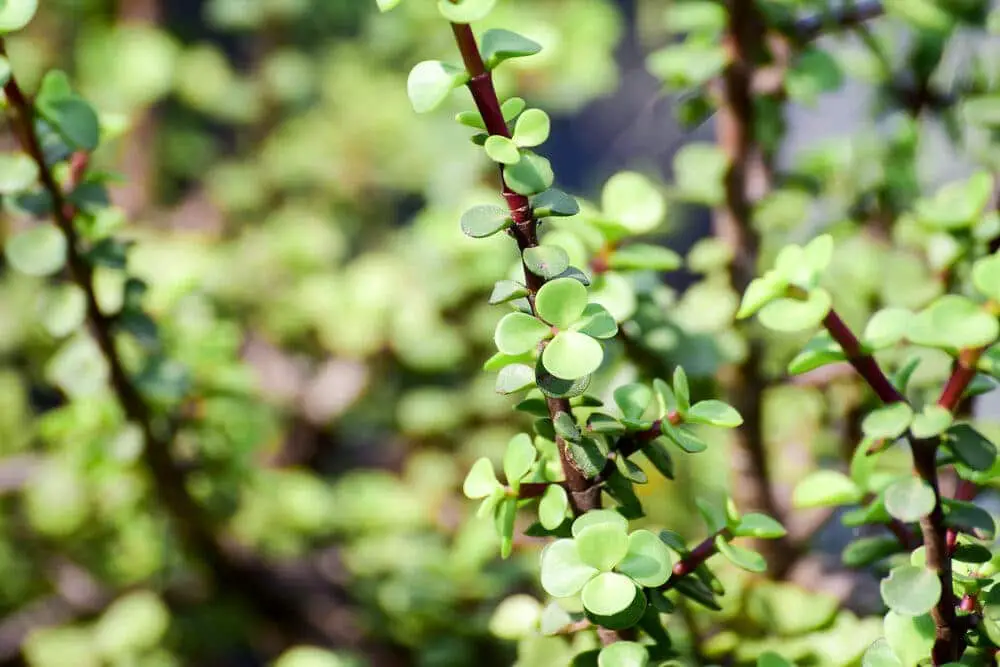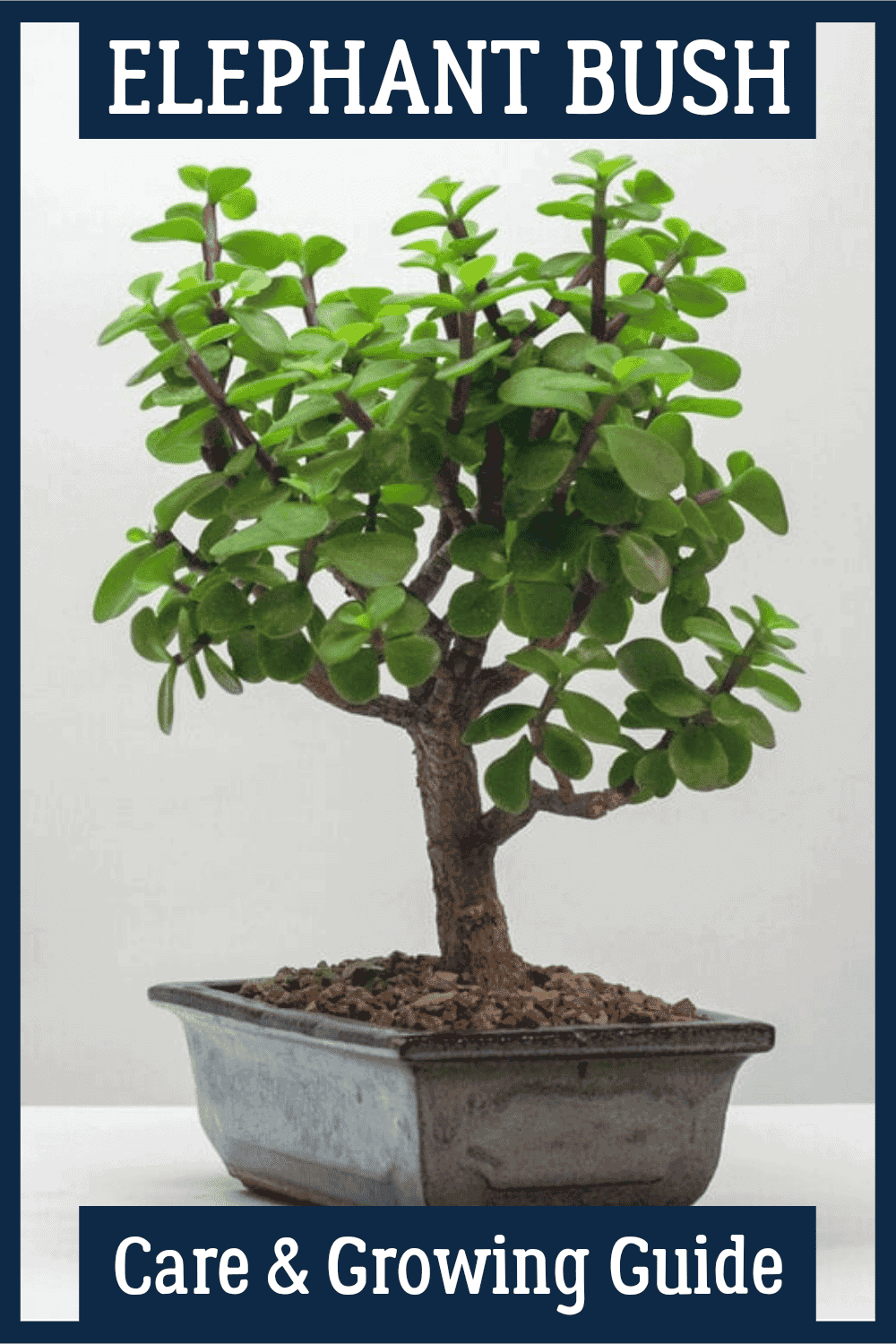The elephant bush is a mighty plant, just like the animal it was named after.
Tall and robust, this plant is an excellent addition to your houseplants. It is best placed next to a bookshelf or tall mantle so that the foliage can climb up up up! The little petals might even remind you of elephant ears.
Elephant Bush Care & Growing Guide
1. Light requirements
The elephant bush loves sunlight and can be in full sun for several hours at a time. But if the plant is not used to a lot of sunlight, you may have to slowly help the plant get used to full direct sunlight. Slowly increase the time you leave the bush out in the sun over a couple of weeks. But the elephant bush’s leaves can get a sunburn if the sun is too intense, like during the height of summer.
2. Water
To water the elephant bush correctly, you must use the soak and dry method. It is exactly what it sounds like. Soak the bush in a lot of water, and then let it dry out over several weeks. During the winter, you may only have to water the bush once a month. These plants are used to experiencing drought and sudden heavy rains, so you don’t have to place them on a watering schedule.
3. Climate
The elephant bush does best when it lives in hot weather, just like in its home on the African plains. The bush can stand a few cold spells but not prolonged periods of cold. If the place you live in is cold, then your elephant bush should stay inside the house with you.
4. Soil
If you are planting the elephant bush outside, then the soil you’re going to place the plant in needs to be sandy and well-draining. Rocky soil always works as well. And for the inside potted plants, basic potting soil or cactus soil would suffice as the soil mix.
Temperature
The elephant bush does best in warm temperatures. It does not like the cold at all, and after a few days outside, the plant will start to wither. This plant should not be outside if it drops lower than 30F.

5. Repotting
If the elephant plant you have is too big for its current container, then you need to relocate the plant into a larger container, so it has room to grow. When you have the pot you want to transfer it too, make sure it can drain at the bottom. Drill extra holes if you need to. Combine some of the old soil in the old pot with new soil, so you don’t give you plant shock when you transfer it into the new soil. Then water lightly and monitor the plant to make sure it is accepting its new home. Don’t add extra fertilizer to the soil right after repotting. Give it a few weeks before you change the composition of the soil.
6. How to propagate the Elephant bush
Because of its long stem, this plant is a great plant to propagate. First, choose a health branch with a lot of leaves on it, and cut the stem all the way to the base where the stem meets the main stem. Plant the stem into the soil and water it thoroughly, but don’t soak it.
7. Height and spread
These large succulents can reach heights of over 12 feet, even if it is an indoor plant. As long as you practice the drought and soak methods and keep it in front of full indirect sunlight, your elephant plant will grow big and strong. The width it can cover is over two feet in diameter, depending on the size of the leaves.
8. Flowers
The elephant bust itself can stand hot weather and humid climate, but it’s flowers cannot. During the spring, its flowers only grow if the environment is mild and the heat isn’t strong. The flowers look like beautiful pink clusters of petals that grow around the elephant bush. They mostly grow along the brown stem of the plant. Sometimes, the flower can come in an arrangement of white, purple, and pink.
Is the Elephant bush plant poisonous?
No, it is not poisonous. Many people actively eat the leaves of the elephant bush. It is used in soups and as topping in salads. The leaves are used as homeopathic medicine, as it is thought to cure aches and pains.

Can Elephant bush plants grow in water?
No, you cannot grow an elephant bush in water. It is not meant to have amounts of water around its roots, as well as its stem and leaves. The elephant bush needs periods of drought to offset any water that is absorbed. If you try to plant this bush in water, you will never see it again because it will wither and die at the bottom of the water.
How to get Elephant bush plants to flower?
What is the worst pest and disease that I will encounter when I have an elephant bush?
Whiteflies are a significant pest to fight when you have an elephant bush that is infested with them. If you shake the plants, all of the whiteflies that have wings will fly into the air. To keep these little pests off of your plant, spray a mixture of neem oil and water onto the entire plant, stem, soil, and the tops and bottoms of the leaves.
Leaf drop occurs when the leaves of the elephant bush fall off of the stem suddenly. This happens because the roots at the bottom of the plant have developed funguses from being overwatered too many times. It can kill the plant quickly, so you must take action. First, repot the bush into brand new soil and remove any diseases root that you can see. After that, do not water for over a week to give the roots time to dry up.
Similar post: Ficus Audrey (Ficus Benghalensis) Care Guide
Conclusion
- This succulent is a popular treat among elephants.
- The elephant bush does best in areas within hardiness zones 10 and 11.
- South Africa is where the elephant bush comes from.
- If you grow it the right way, the leaves of the elephant plant can be a tasty ingredient.
- The drought and soak method is the best way to make sure you’re not overwatering your plant.

Victoria is the owner and main author of hobby plants. She loves spending her free time in her garden planting and taking care of her plants. Victoria hopes you enjoy the content here!
![Bush On Fire Croton Plant Care: [Complete Beginner's Guide] Bush On Fire Croton Plant Care: [Complete Beginner's Guide]](https://www.hobbyplants.com/wp-content/uploads/2022/09/bush-on-fire-croton-300x158.jpg)
![Mother Of Thousands Plant [Complete Plant Care Guide] Mother Of Thousands Plant [Complete Plant Care Guide]](https://www.hobbyplants.com/wp-content/uploads/2022/07/mother-of-thousands-plant-300x158.jpg)
![How Often Should You Water Pothos? [Complete Care Guide] How Often Should You Water Pothos? [Complete Care Guide]](https://www.hobbyplants.com/wp-content/uploads/2022/07/how-often-to-water-pothos-300x158.jpg)
![Can Snake Plants Live Outside? [COMPLETE CARE GUIDE] Can Snake Plants Live Outside? [COMPLETE CARE GUIDE]](https://www.hobbyplants.com/wp-content/uploads/2022/08/can-snake-plants-live-outside-300x158.jpg)
![Majesty Palm Plant Care: [Complete Beginner's Guide] Majesty Palm Plant Care: [Complete Beginner's Guide]](https://www.hobbyplants.com/wp-content/uploads/2022/08/majesty-palm-care-300x158.jpg)
![Exotic Angel Plant Care: [Complete Beginner's Guide] Exotic Angel Plant Care: [Complete Beginner's Guide]](https://www.hobbyplants.com/wp-content/uploads/2022/08/exotic-angel-plant-care-300x158.jpg)
![Do Coleus Like Sun Or Shade: [Complete Care Guide] Do Coleus Like Sun Or Shade: [Complete Care Guide]](https://www.hobbyplants.com/wp-content/uploads/2022/08/coleus-sun-or-shade-300x158.jpg)
![Snow White Waffle Plant: [Complete Care Guide] Snow White Waffle Plant: [Complete Care Guide]](https://www.hobbyplants.com/wp-content/uploads/2022/08/snow-white-waffle-plant-300x158.jpg)
![Waffle Plant Care: [Complete Beginner's Guide] Waffle Plant Care: [Complete Beginner's Guide]](https://www.hobbyplants.com/wp-content/uploads/2022/08/waffle-plant-300x158.jpg)
![Bird Of Paradise Plant Care: [Complete Beginner's Guide] Bird Of Paradise Plant Care: [Complete Beginner's Guide]](https://www.hobbyplants.com/wp-content/uploads/2022/08/bird-of-paradise-plant-300x158.jpg)
![Purple Passion Plant Care: [Complete Beginner's Guide] Purple Passion Plant Care: [Complete Beginner's Guide]](https://www.hobbyplants.com/wp-content/uploads/2022/08/purple-passion-plant-care-300x158.jpg)
![China Doll Plant Care: [Complete Beginner's Guide] China Doll Plant Care: [Complete Beginner's Guide]](https://www.hobbyplants.com/wp-content/uploads/2022/09/china-doll-plant-care-300x158.jpg)